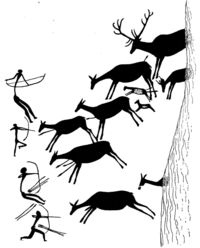
Photo from wikipedia
Hepatitis E virus (HEV) is a common causative agent of acute hepatitis in the world, with a serious public health burden in both developing and industrialized countries. Cervids, along with… Click to show full abstract
Hepatitis E virus (HEV) is a common causative agent of acute hepatitis in the world, with a serious public health burden in both developing and industrialized countries. Cervids, along with wild boars and lagomorphs, are the main wild hosts of HEV in Europe and constitute a documented source of infection for humans. The aim of this study was to evaluate the presence of HEV in roe deer (Capreolus capreolus) and fallow deer (Dama dama) living in Tuscany, Central Italy. Liver samples from 48 roe deer and 60 fallow deer were collected from carcasses during the hunting seasons. Following the results obtained from molecular and histopathologic studies, 5/48 (10.4%) roe deer and 1/60 (1.7%) fallow deer liver samples were positive for the presence of HEV RNA. All PCR-positive livers were also IHC-positive for viral antigen presence, associated with degenerative and inflammatory lesions with predominantly CD3+ cellular infiltrates. This study represents the first identification in Italy of HEV RNA in roe and fallow deer and the first study in literature describing liver alterations associated with HEV infection in cervids. These results demonstrate that HEV is present in wild cervid populations in Italy and confirm the potential zoonotic role of these species.
Journal Title: Veterinary Sciences
Year Published: 2022
Link to full text (if available)
Share on Social Media: Sign Up to like & get
recommendations!